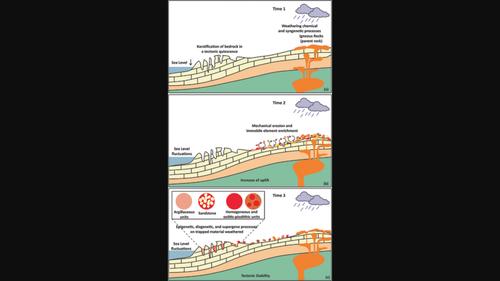当前位置:
X-MOL 学术
›
Geolog. J.
›
论文详情
Our official English website, www.x-mol.net, welcomes your
feedback! (Note: you will need to create a separate account there.)
Mineralogy and geochemistry of Permian–Triassic lateritic-bauxitic horizons, eastern and central Alborz, Iran: Implications for provenance, palaeogeography, and palaeoclimate
Geological Journal ( IF 1.4 ) Pub Date : 2022-09-14 , DOI: 10.1002/gj.4585 Forough Abasaghi 1 , Asadollah Mahboubi 1 , Mohammad Hosein Mahmudi Gharaie 1 , Mohammad Khanehbad 1
Geological Journal ( IF 1.4 ) Pub Date : 2022-09-14 , DOI: 10.1002/gj.4585 Forough Abasaghi 1 , Asadollah Mahboubi 1 , Mohammad Hosein Mahmudi Gharaie 1 , Mohammad Khanehbad 1
Affiliation

|
This paper presents a survey of geological attributes on the lateritic-bauxitic deposits to examine their provenance, palaeogeography, and palaeoclimate condition in the Permian–Triassic boundary of Alborz Mountain, north Iran. The mineralogical analysis revealed that haematite, quartz, goethite, kaolinite, diaspore, boehmite, and anatase are the major rock-forming minerals in these deposits. The major oxide composition of samples detected that enrichment of Al2O3 (up to 31.5%) and Fe2O3 (up to 37.9%) led to the formation of laterite, kaolinitic laterite, and bauxitic kaolinite. The distribution of trace and rare elements provides information about the enrichment of deposits concerning immobile elements. Employing geochemical proxies such as Al2O3/TiO2, bivariate diagrams of Eu/Eu* versus Sm/Nd and TiO2/Al2O3, enrichment of samples relative to heavy rare earth elements, and positive Eu anomaly revealed that the deposits originated from intermediate to mafic rocks. Several factors are inferred to be responsible for the transformation of parent rock(s) into lateritic-bauxitic deposits: The high values of CIA, CIW, and PIA (mostly above 80) and increase of kaolinite point to deep to moderate parent rock(s) weathering, which is consistent with warming and humidity around the Permian–Triassic boundary. In continuation, transportation and trapping of weathered materials above the karstified carbonate bedrock of the Ruteh Formation and environmental interactions induced the formation of new minerals in a transitional environment near the vadose zone. The deposits have a generic correspondence with Palaeotethys Oceanic crustal subduction due to tectonic uplift, exhumation of bedrock, and regional sea-level fall at the end of Palaeozoic that offered an opportunity for lateritization process.
中文翻译:

伊朗阿尔伯兹省东部和中部二叠纪-三叠纪红土-铝土层的矿物学和地球化学:对物源、古地理和古气候的影响
本文对伊朗北部厄尔布尔士山二叠纪-三叠纪边界的红土-铝土矿床的地质属性进行了调查,以检验其来源、古地理和古气候条件。矿物学分析表明,赤铁矿、石英、针铁矿、高岭石、水铝石、勃姆石和锐钛矿是这些矿床中的主要造岩矿物。样品的主要氧化物成分检测到富集Al 2 O 3 (高达31.5%)和Fe 2 O 3(高达 37.9%) 导致红土、高岭土红土和铝土高岭土的形成。微量元素和稀有元素的分布提供了有关固定元素矿床富集的信息。使用地球化学替代物,例如 Al 2 O 3 /TiO 2、Eu/Eu* 与 Sm/Nd 和 TiO 2 /Al 2 O 3的双变量图, 相对于重稀土元素的样品富集和正 Eu 异常表明矿床起源于中基性岩。推断有几个因素导致母岩向红土-铝土矿床的转变:CIA、CIW 和 PIA 的高值(大部分高于 80)和高岭石点向深至中等母岩的增加) 风化,这与二叠纪-三叠纪边界周围的变暖和湿度一致。在 Ruteh 组岩溶碳酸盐岩基岩上方的风化物质的运输和捕获以及环境相互作用继续在包气带附近的过渡环境中形成新矿物。
更新日期:2022-09-14
中文翻译:

伊朗阿尔伯兹省东部和中部二叠纪-三叠纪红土-铝土层的矿物学和地球化学:对物源、古地理和古气候的影响
本文对伊朗北部厄尔布尔士山二叠纪-三叠纪边界的红土-铝土矿床的地质属性进行了调查,以检验其来源、古地理和古气候条件。矿物学分析表明,赤铁矿、石英、针铁矿、高岭石、水铝石、勃姆石和锐钛矿是这些矿床中的主要造岩矿物。样品的主要氧化物成分检测到富集Al 2 O 3 (高达31.5%)和Fe 2 O 3(高达 37.9%) 导致红土、高岭土红土和铝土高岭土的形成。微量元素和稀有元素的分布提供了有关固定元素矿床富集的信息。使用地球化学替代物,例如 Al 2 O 3 /TiO 2、Eu/Eu* 与 Sm/Nd 和 TiO 2 /Al 2 O 3的双变量图, 相对于重稀土元素的样品富集和正 Eu 异常表明矿床起源于中基性岩。推断有几个因素导致母岩向红土-铝土矿床的转变:CIA、CIW 和 PIA 的高值(大部分高于 80)和高岭石点向深至中等母岩的增加) 风化,这与二叠纪-三叠纪边界周围的变暖和湿度一致。在 Ruteh 组岩溶碳酸盐岩基岩上方的风化物质的运输和捕获以及环境相互作用继续在包气带附近的过渡环境中形成新矿物。









































 京公网安备 11010802027423号
京公网安备 11010802027423号